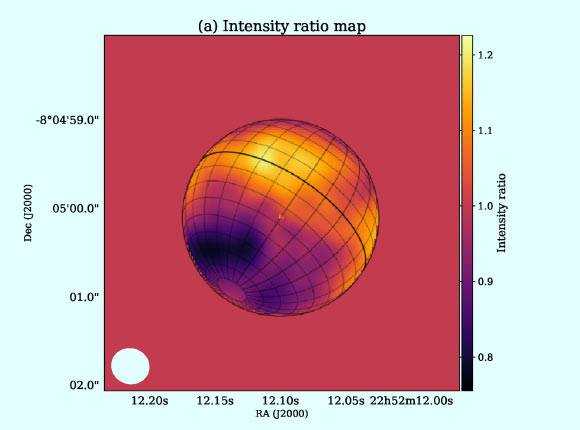Astronomers using the Atacama Large Millimeter / submillimeter Array (ALMA) have produced a detailed map of the intensity and abundance of hydrogen cyanide gas in the upper stratosphere of Neptune, the eighth-most planet in the solar system. away from the Sun.
This image of Neptune was produced from the latest images of the entire planet taken through the green and orange filters of the narrow-angle camera of NASA’s Voyager 2 spacecraft. The images were taken at a distance of 7.1 million km (4.4 million miles) from the planet, 4 days and 20 hours before the nearest approach. The photo shows the large dark spot and its companion light spot; on the west branch, the fast light function called Scooter and the small dark spot are visible. These clouds have been seen to persist as long as Voyager’s cameras can resolve them. To the north of these, a bright cloud band similar to the south polar streak can be seen. Image credit: NASA / JPL.
Neptune is the only planet in the solar system not visible to the naked eye due to its extreme distance from Earth and the first mathematically predicted before its discovery.
Nearly 4.5 billion km (2.8 billion miles) from the Sun, it orbits our star once every 165 years. Interestingly, Pluto’s highly eccentric orbit brings the dwarf planet inside Neptune’s orbit for a period of 20 out of 248 Earth years.
The atmosphere of Neptune is compound mainly molecular hydrogen, atomic helium and methane.
The blue color of Neptune is the result of methane in the atmosphere. Uranus’ blue-green color is also a result of atmospheric methane, but Neptune is a brighter, brighter blue, so there must be some unknown component causing the more intense color.
“Neptune revolves around the Sun at the outermost end, and its atmosphere is mainly composed of hydrogen and helium, like other gaseous planets such as Jupiter, Saturn and Uranus,†said Dr. Takahiro Iino of the University of Tokyo and colleagues.
“What sets Neptune apart from other gaseous planets is that, according to previous studies, it contains an abundance of hydrogen cyanide gas in the upper stratosphere.”

Map of the intensity ratio (value measured with respect to the radially averaged profile) of hydrogen cyanide; the white ellipse at the bottom left illustrates the shape of the synthesized beam. Image Credit: Iino et al., doi: 10.3847 / 2041-8213 / abbb9a.
Astronomers analyzed archival data collected by ALMA on April 30, 2016.
“The maximum intensity of hydrogen cyanide was found around the equator (about 1.7 ppb), while it was most depleted around 60 degrees south (about 1.2 ppb)”, have- they stated.
“For reference, 1 ppb means that one molecule of hydrogen cyanide is present per 1 billion atmospheric molecules.”
The belt-like distribution of hydrogen cyanide can be interpreted as the effect of nitrogen transport from the Neptune troposphere through the meridional atmospheric circulation, or as an external source such as cometary collisions.
“Large atmospheric fluxes can trigger an inhomogeneous spatial distribution of trace molecules in a planet’s atmosphere. For example, ozone in the Earth’s atmosphere is distributed unevenly, â€the researchers said.
“The Earth’s stratospheric ozone is characterized by its higher concentration at high latitudes. This is due to the movement of air from low latitudes to high latitudes in the stratosphere where ozone is produced. “
“Based on this, we assumed that different concentrations of hydrogen cyanide on Neptune would be attributed to the stratospheric circulation,” they added.
“To put it in other words, an ascending branch is generated in the mid-latitude where hydrogen cyanide is most depleted, and then carries nitrogen molecules, a source of hydrogen cyanide, to the stratosphere. “
“These nitrogen molecules are then transported to the equator and the south pole, while producing hydrogen cyanide by photochemical reactions in the stratosphere.”
“Our study strongly supports the possibility that massive atmospheric movement or general circulation exists in Neptune, and induces the production of hydrogen cyanide in the stratosphere,” they concluded.
A paper on the results was published in the Letters from the Astrophysical Journal.
_____
Takahiro Iino et al. 2020. A belt-like distribution of hydrogen cyanide gas over the equatorial stratosphere of Neptune detected by ALMA. ApJL 903, L1; doi: 10.3847 / 2041-8213 / abbb9a
 Universo Viviente
Universo Viviente



